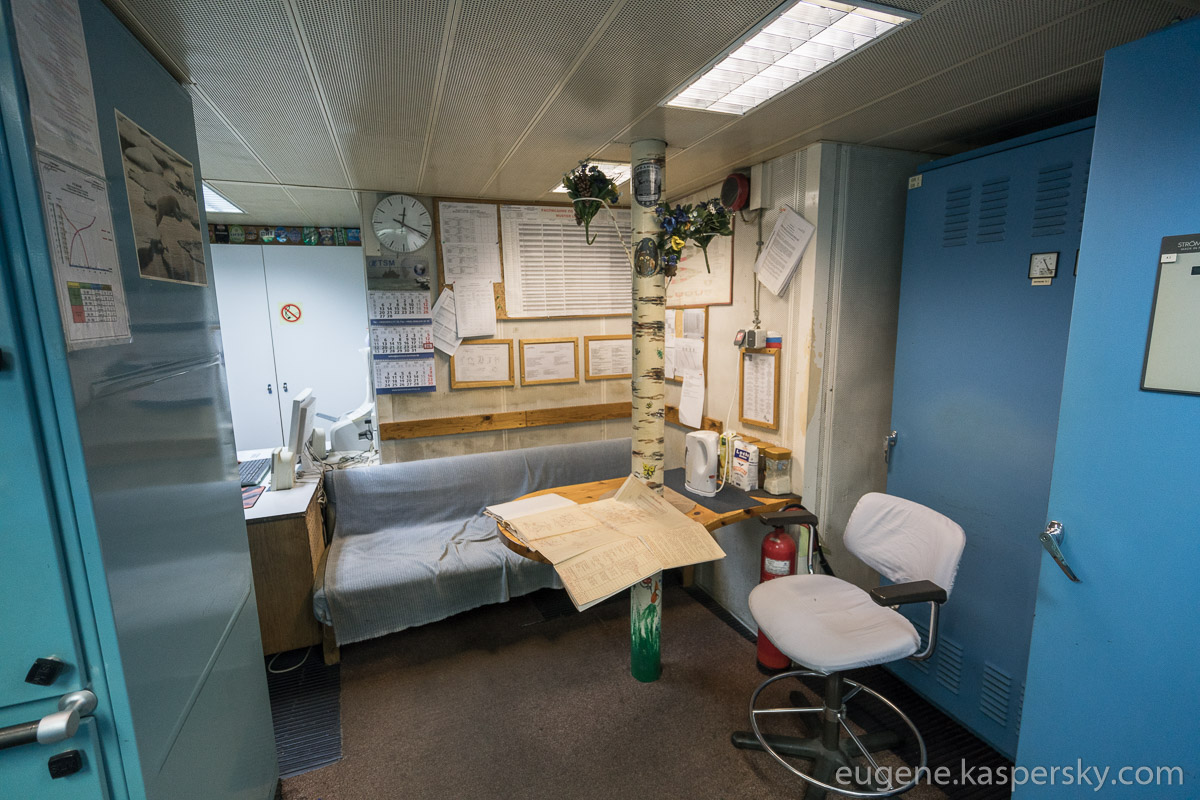April 15, 2017
A Floating Hotel – Almost.
I can’t tell you all about my Antarctic adventure without telling you all about the ship we sailed across the Drake Passage on. So here we go folks, a post on the one and only Akademik Sergey Vavilov. Here she is, in all her glory:
First up, the engine room. Here’s it’s all about electronic automation, but more of an analogue kind (see the analogue dials) than the full-on digitization of today – a sign that this ship was born in 1988. Yep, that’s when the ship first hit the water – in Rauma in Finland (be ready for quite a bit of Finnish language coming up…). Back then this was state of the art; still today it does a grand job…
The navigation and autopilot systems – now they are fully modern-digital:
Here’s the take-a-break room for the non-working shift; a shift, if my memory serves me well, lasts four hours.
The ship is propelled by two 3500-horsepower engines. Everything clean, neatly painted, fully labelled. Nice. Sure, the volume here is up-to-11 as you’d expect, but there’s no sloppy rattling of the various parts. Smooth. Efficient.
Here’s the steering kit – both automatic and manual. It’s the link between the engine room and the rudder. There’s also down here a back-up engine, generators and other necessary maritime knick-knacks.
I think this here is the rudder yoke, which constantly moves to the left and right to maintain the desired heading.
Somewhere around here is the ship’s stabilization system. It’s made up of special tanks in the lower hold in which water is pumped in or out – to the left and to the right – to compensate for the ship’s tilt caused by the elements (sea currents; maybe wind…). Well, well! I didn’t realize such tech was so old; I thought it was much ‘younger’. You live and learn…
Onwards with our tour of the Vavilov…
Next up – the ship’s distiller for turning seawater into drinking water. Next to it – the furnace for burning garbage.
Here’s the back-up helm, for in case the standard steering kit all goes to pot. Er, but no power steering here like on cars: to turn the ship just 5% to the right of left takes… 125 complete full turns of the wheel!
Here are the ‘comms’ for talking to the bridge. Can’t beat analogue, eh? :).
Next up: elevator, Samsung, snow:
Our route marked out on the map:
The spare anchor:
Now about the cabins. They mostly sleep two separately. There are two VIP cabins – one for the captain, and one – normally – for the expedition chief. I was lucky enough to get the latter! Not bad at all it was. It even had a mini-bar :).
About Internet…
It was accessible from onboard – via satellite. Two options can be paid for: email use ($30 for the whole trip) and Internet traffic ($50 per 100MB). The email works fine, with attachments weighing up to 300KB flying off nice and smoothly. But the Internet is best accessed via a smartphone. Desktops quickly eat up the remaining megabytes with service traffic generated by the operating system. But for the rest – a very decent satellite connection (256Kbit).
A huge thank you to all the ship’s crew – the engine men, engineers, hands, cook, and last but not least – the captain, Gennady Poskonni!
As promised – here’s a bigger shout-out to those cool dudes from OneOcean Expeditions – the US–Canadian tour operators who looked after ~50 kooky creators on their audacious Antarctic adventure. No easy task – and certainly not something they’d done before. But they did great. Big up OOE :).
And that, ladies and gents, is about all about the Vavilov. Next up it was port > mooring > goodbyes > and already the Antarctic nostalgia kicking in…
The nostalgia peaked at the post-expedition press conference in Buenos Aires:
And here’s Buenos Aires again flying out and heading northeast…
Meanwhile, the Vavilov was setting sail again, this time on a scientific mission – no tourists/artists! It’s currently sailing to warmer climes – as confirmed by the captain who kindly emailed me. I quote:
“We’re heading north to the scientific testing area above the Wima – a deep chasm on the seabed through which cold Antarctic waters move up to the equator and beyond. The scientists drop cables with thermometers and bathometers down some 4km to take samples. The samples are analyzed on the ship, and then again back at the institute the scientists hail from. They’re investigating the effect of this cold water on climate and weather; it’s a long-term study program”…
If there are any scientists among you, dear readers, tell me if I’m wrong with the following:
When freezing, salt doesn’t wind up in the ice; it’s ‘squeezed out’ during the freezing process. As a result we get super salty seawater anywhere near big-league ice. And the freezing point of salty water is lower, so it’s not only super salty but super cold too; it thus sinks to the bottom of the ocean and ‘flows’ along the bed of the Atlantic, crosses the equator, and then goes further – right up to Greenland! The scientists on the Vavilov are now taking samples of that very, very very cold water – with this:
I wish them the best of luck – including good weather! Indeed, a toast! Cheers to that!…
Back tomorrow folks, with more tales from the Antarctic side…



























































